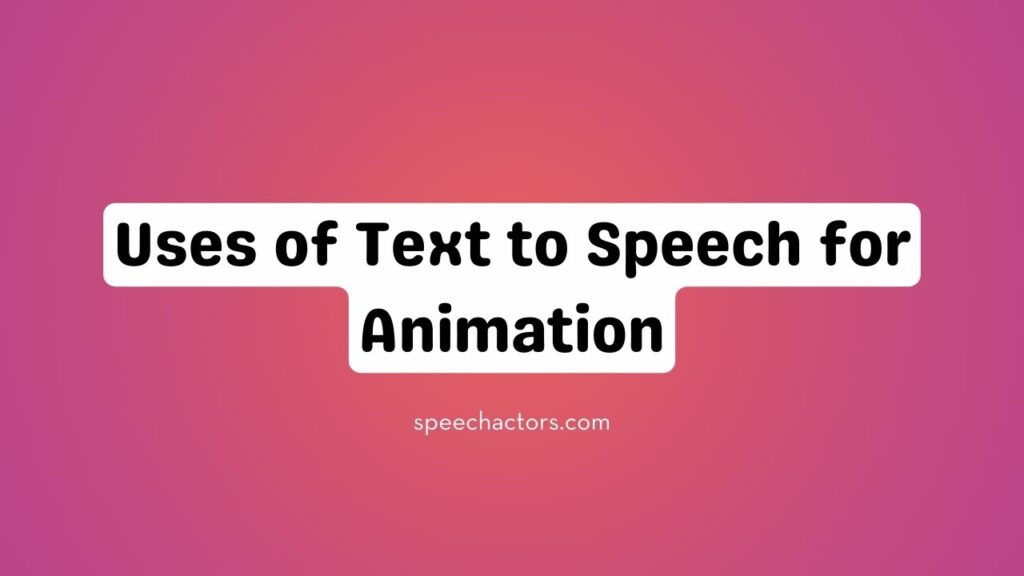Text-to-Speech (TTS) technology transforms written text into natural, expressive voice, opening new possibilities for animation creators. In animation and storytelling, voice brings characters to life, adding emotion, personality, and depth to every scene.
By integrating TTS, animators can streamline production workflows, quickly generate diverse character voices, and experiment with narration without extensive recording sessions.
This technology not only saves time but also expands creative flexibility, allowing storytellers to focus on crafting engaging narratives while ensuring every character resonates with audiences through authentic and dynamic voice performances.
Role of TTS in Animation
The role of TTS in animation is to give animated characters natural and expressive voices without the need for manual recording.
Text-to-Speech (TTS) works by converting written dialogue into spoken audio, which can be synchronized with character movements and lip-sync software. This helps animators test scenes quickly and bring scripts to life even in early production stages.
TTS also saves time and cost by reducing dependency on voice actors for drafts and revisions. In animation projects, the benefits include faster content creation, easier localization into multiple languages, and more flexibility in editing dialogues to match visual storytelling.
Key Uses of TTS in Animation
Creating character voices without hiring voice actors: TTS generates distinct voices for animated characters, reducing dependency on professional actors during early or full production.
Generating multilingual voiceovers for global audiences: TTS provides accurate voiceovers in multiple languages, helping animations reach international viewers more effectively.
Quick prototyping and testing of dialogue and scripts: TTS allows creators to test timing, tone, and dialogue flow before final recording, speeding up pre-production.
Enhancing accessibility for visually impaired viewers: TTS supports audio descriptions and dialogue narration, making animated content inclusive for all audiences.
Streamlining production workflow and reducing costs: TTS automates voice generation, lowering expenses for dubbing and speeding up the overall animation process.
Strategies to Implement TTS in Animation

Strategies to Implement TTS in Animation focus on creating natural, character-driven voiceovers that blend smoothly with visuals. The first step is selecting high-quality TTS software like Speechactors, which provides realistic voices and multiple customization options.
Once the tool is chosen, it is important to match voices to character personalities, ensuring each role sounds authentic. Additionally, adjusting tone, pitch, and speech speed helps deliver emotions that feel lifelike.
The final step is integrating TTS with animation and video editing software, allowing voices to sync seamlessly with character lip movements and scene timing. Together, these strategies make animations engaging and professional.
Case Studies: TTS in Successful Animation Projects
Text-to-Speech (TTS) has been widely used in animation projects to speed up production and add creative flexibility. Studios have adopted TTS voices for pre-visualization and even final delivery in short films, explainer videos, and animated series.
For example, indie animators have used TTS in pilot episodes to test character voices before hiring actors, while educational animation studios rely on it to create multiple language versions quickly.
Animators and production teams share positive feedback, noting that TTS saves recording time, lowers costs, and offers consistent voice quality. Many highlight that AI-driven voices help them experiment with tone, pacing, and dialogue delivery, making the creative process smoother and more efficient.
Future of TTS in Animation
The future of TTS in animation is lifelike, controllable, and fast, with voices tailored to each character’s style, age, accent, and emotion.
AI-driven voice customization lets creators set pitch, pace, timbre, and prosody, then add emotional intonation like joy, fear, or calm for scene-level nuance. Style tokens and speaker embeddings help keep voices consistent across episodes while allowing safe, consented cloning for franchise characters.
Furthermore, multilingual TTS supports instant dubbing with timing that fits lip movements. Emerging trends include real-time TTS for previs, interactive shorts that change dialogue on the fly, and pipeline-ready TTS that plugs into storyboards and animatics. This brings rapid iteration, personalized experiences for fans, and accessible content for global audiences.
Frequently Asked Questions (FAQs)
How does TTS support learners with disabilities?
TTS reads text aloud clearly, helping learners with visual impairments or reading difficulties follow lessons. Research shows audio support improves comprehension and confidence in learning.
Can TTS help ESL learners understand content better?
TTS speaks content naturally, letting ESL learners hear correct pronunciation and rhythm. Studies show listening while reading boosts language understanding by up to 40%.
What makes Speechactors’ voices suitable for inclusivity?
Speechactors offers natural, diverse voices that feel human, supporting all learners. Its clarity, tone, and expressiveness make lessons accessible and engaging for everyone.
How easy is it to integrate Speechactors into LMS or e-learning platforms?
Speechactors integrates seamlessly with most LMS systems using API tools. Educators can convert text to speech quickly, making courses accessible without extra technical work.
Can TTS improve engagement for neurodiverse students?
TTS delivers content consistently with adjustable speed and voice, helping neurodiverse students stay focused. Studies show audio learning increases attention and retention in diverse learners.
Conclusion
Text-to-speech for animation revolutionizes the way creators bring characters to life, offering faster production, consistent voice quality, and flexible experimentation. By integrating TTS, animators can save time, enhance creativity, and achieve professional-grade voiceovers without heavy costs or delays.
Platforms like Speechactors provide a diverse range of expressive voices tailored for animation, making it easier than ever to elevate storytelling. Embrace TTS in your projects today and transform your animations with dynamic, realistic voices that captivate audiences and streamline your workflow.
